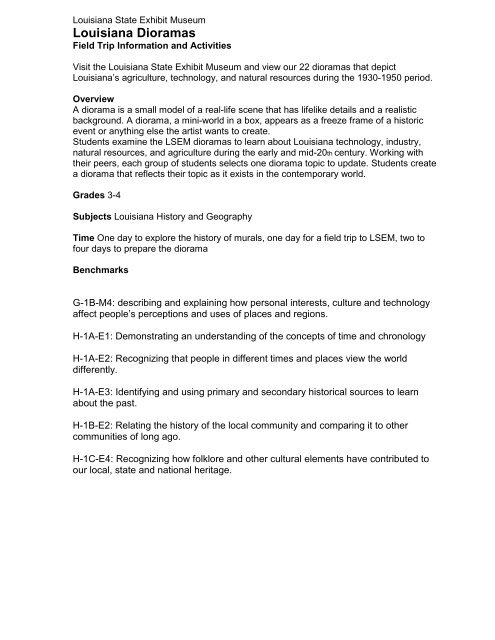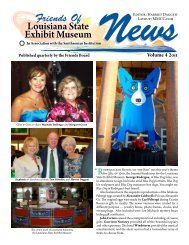Diorama Experience for Grades 3-4 - The Louisiana State Exhibit ...
Diorama Experience for Grades 3-4 - The Louisiana State Exhibit ...
Diorama Experience for Grades 3-4 - The Louisiana State Exhibit ...
Create successful ePaper yourself
Turn your PDF publications into a flip-book with our unique Google optimized e-Paper software.
<strong>Louisiana</strong> <strong>State</strong> <strong>Exhibit</strong> Museum<br />
<strong>Louisiana</strong> <strong>Diorama</strong>s<br />
Field Trip In<strong>for</strong>mation and Activities<br />
Visit the <strong>Louisiana</strong> <strong>State</strong> <strong>Exhibit</strong> Museum and view our 22 dioramas that depict<br />
<strong>Louisiana</strong>’s agriculture, technology, and natural resources during the 1930-1950 period.<br />
Overview<br />
A diorama is a small model of a real-life scene that has lifelike details and a realistic<br />
background. A diorama, a mini-world in a box, appears as a freeze frame of a historic<br />
event or anything else the artist wants to create.<br />
Students examine the LSEM dioramas to learn about <strong>Louisiana</strong> technology, industry,<br />
natural resources, and agriculture during the early and mid-20th century. Working with<br />
their peers, each group of students selects one diorama topic to update. Students create<br />
a diorama that reflects their topic as it exists in the contemporary world.<br />
<strong>Grades</strong> 3-4<br />
Subjects <strong>Louisiana</strong> History and Geography<br />
Time One day to explore the history of murals, one day <strong>for</strong> a field trip to LSEM, two to<br />
four days to prepare the diorama<br />
Benchmarks<br />
G-1B-M4: describing and explaining how personal interests, culture and technology<br />
affect people’s perceptions and uses of places and regions.<br />
H-1A-E1: Demonstrating an understanding of the concepts of time and chronology<br />
H-1A-E2: Recognizing that people in different times and places view the world<br />
differently.<br />
H-1A-E3: Identifying and using primary and secondary historical sources to learn<br />
about the past.<br />
H-1B-E2: Relating the history of the local community and comparing it to other<br />
communities of long ago.<br />
H-1C-E4: Recognizing how folklore and other cultural elements have contributed to<br />
our local, state and national heritage.
Pre-Visit Activity<br />
1. Introduce students to the concept of dioramas— a small model of a real-life<br />
scene that has lifelike details and a realistic background; a re-creation of a<br />
natural setting which shows a specific moment in time. Show examples of<br />
student-produced dioramas, such as the pictures below, and visit the American<br />
Museum of Natural History on the Internet at<br />
http://www.amnh.org/exhibitions/dioramas/ to demonstrate how museums use<br />
dioramas to illustrate the world in which we live.<br />
2. Explain that the class will visit the <strong>Louisiana</strong> <strong>State</strong> <strong>Exhibit</strong> Museum to view 22<br />
dioramas about <strong>Louisiana</strong> industry, agriculture, and natural resources. Explain that<br />
these murals reveal in<strong>for</strong>mation about <strong>Louisiana</strong> during the early and mid-20th century.<br />
3. Tell students that they will examine how the dioramas reveal in<strong>for</strong>mation about a<br />
specific topic. Working with their peers, your class can select one diorama topic to<br />
update by creating a diorama that reflects their topic as it exists in the contemporary<br />
world with teacher guidence
Museum Field Trip Activity<br />
1. Make copies of the LSEM <strong>Diorama</strong> Viewing Journal, one per student.<br />
2. Explain the journal organization and project instructions.<br />
Post-Visit Activity and Project<br />
1. Discuss student impressions of the LSEM dioramas. Ask students to explain the<br />
different ways the dioramas relayed in<strong>for</strong>mation about <strong>Louisiana</strong>.<br />
2. Distribute copies of the <strong>Diorama</strong> Design Instructions and Storyboard activity sheet,<br />
explaining the process of creating a diorama.<br />
3. Provide time <strong>for</strong> student research as well as diorama design and construction.<br />
4. Create a diorama gallery or display.<br />
5. Send pictures of the dioramas to us at the address listed below <strong>for</strong> a chance to have<br />
your class dioramas featured on our Internet site.<br />
<strong>Louisiana</strong> <strong>State</strong> <strong>Exhibit</strong> Museum<br />
3015 Greenwood Road<br />
Shreveport, LA 71109<br />
318.632.2020<br />
www.sos.louisiana.gov/lsem<br />
Education Curator<br />
<strong>Louisiana</strong> <strong>State</strong> <strong>Exhibit</strong> Museum<br />
3015 Greenwood Road Shreveport, LA 71109<br />
Museum hours: Monday through Friday, 9 a.m. to 4 p.m.; Saturday and Sunday, noon to 4 p.m
<strong>Louisiana</strong> <strong>State</strong> <strong>Exhibit</strong> Museum<br />
<strong>Diorama</strong> Viewing Journal Name _________________________<br />
Date __________________________<br />
School ________________________<br />
A diorama is a small three-dimensional model of a real-life scene that has lifelike details<br />
and a realistic background.<br />
Use in<strong>for</strong>mation you gain from the 22 LSEM dioramas to complete this viewing journal.<br />
PART 1 INTRODUCTION TO THE LSEM DIORAMAS<br />
1. Walk through the LSEM diorama display gallery to get an overview of the topics and<br />
subjects on display. List four major themes that the dioramas illustrate.<br />
_______________________________ _____________________________<br />
_______________________________ _____________________________<br />
2. What features do the dioramas have in common?<br />
3. Why do you think museum audiences like to view dioramas?<br />
PART 2 SELECT ONE DIORAMA TO EXAMINE IN DETAIL<br />
5. I chose to examine the _____________________________ diorama.<br />
6. What story does this diorama tell?<br />
7. List some of the objects that are most important in relating this story.<br />
8. What facts can you learn from this diorama?<br />
PART 3 SUMMARY STATEMENT<br />
Write one sentence that describes why you think the LSEM dioramas are important.<br />
______________________________________________________________________<br />
______________________________________________________________________<br />
______________________________________________________________________
<strong>Diorama</strong> Design Instructions and Storyboard<br />
1. Decide on a story. What moment, event, scene, facts do you want to capture? Think<br />
about how you can relay in<strong>for</strong>mation about your topic without using words. Try to find ways<br />
to leave the viewers wondering what will happen next. If you are making a bayou diorama,<br />
you could capture the moment just be<strong>for</strong>e a big fish is about to gobble up a little fish. This<br />
tells a story. Use the <strong>Diorama</strong> Storyboard handout to plan your scene.<br />
Story Ideas<br />
2. Decide on a scale. This is important, because a diorama becomes believable to the<br />
extent that it looks "real." If you have a focus (a plastic figure or animal that is the main<br />
object in your diorama), use that scale. That is, make certain the other objects you use<br />
appear in the correct proportion to your focus item. If not, try a scale of 1 foot to 1 inch. That<br />
is the standard scale <strong>for</strong> miniature buildings and houses.<br />
3. Collect your materials. Collect human and/or animal figures, trees, sugar cubes to build<br />
an igloo, or doll house furniture and miniature foods <strong>for</strong> an interior scene.<br />
4. Decide on a background. You can paint or draw your own or use wallpaper or wrapping<br />
paper or anything else you can find. Remember that the background images should be<br />
consistent with the scale you have chosen.<br />
Background Ideas<br />
5. Choose a container. Many diorama projects use cardboard boxes or shoe boxes, but<br />
you can use just about anything. Your container should be light but sturdy, especially if you<br />
will need to move the diorama around.<br />
6. Build your diorama working from the back to the front. Start with the background by<br />
creating the horizon, sky/ceiling, and ground/floor. Make certain the paint and glue is dry<br />
be<strong>for</strong>e placing objects in the diorama. First, place large objects such as trees. Place the<br />
smallest objects close to the front. Use glue or putty to secure the objects.<br />
Things You Might Need:<br />
cardboard box, shoe box, or other container<br />
dollhouse dolls<br />
miniature animals and trees<br />
hobby paintbrushes<br />
miniature food, vegetation, and/or building elements<br />
modeling clay<br />
poster paint<br />
glue or putty<br />
acrylic paint or paper <strong>for</strong> backdrop




